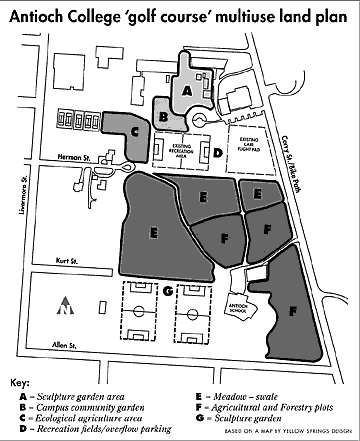                         |
|
Multiuse
strategy proposed
for
Antioch ‘golf course’ area
 |
| |
A group that studied
possible uses of the Antioch College “golf course” has recommended
the college implement a multiuse plan for the 25-acre property.
Prepared by the Antioch College Golf Course Task Force, a group of Antioch
students, professors and village residents, the plan, called the “Antioch
College Commons Multi-Use Land Plan,” recommends the golf course
include room for reforestation, community gardens and open green space.
Although the plan is by no means considered the final word on the future
of the land, it is intended to be a well-planned recommendation.
“Everyone seems pleased with the proposal so far,” Antioch College
President Joan Straumanis said.
Over the summer, the task force, along with members of the Antioch and
Yellow Springs communities, met every Thursday to discuss the future of
the property along Corry Street.
Bob Whyte, executive director of the Glen Helen Ecology Institute and
chairman of the task force, said all the long hours and creative energy
finally produced a plan based on consensus. “Not everyone got exactly
what they wanted, but we did get everyone an element of what they wanted,”
he said.
In addition to Whyte, the task force also included Antioch student Nathan
Smith; Antioch biological and environmental sciences professor Tom Ayrsman;
Antioch University Board of Trustees member Bill Hooper; Village Manager
Rob Hillard; Roger Beal, a landscape architect and the owner of Yellow
Springs Design; Antioch School board president Karen Wintrow; and Antioch
biological and environmental sciences professor Peter Townsend.
More than 30 people, ranging from Antioch College students to Antioch
School representatives to Yellow Springs residents, met with the task
force every week, bringing their own suggestions and complaints, Whyte
said.
The Village purchased the golf course from Antioch College in 1981 when
the college was experiencing a financial crisis. When the college purchased
the land back from the Village in 1991, Village Council passed an ordinance
that prohibited the college from trying to change the golf course’s
zoning designation to a status that “might allow commercial or private
residential use.”
Beyond legal matters, serious efforts to change the golf course into anything
other than green space have not arisen, although debate about the land
in the past decade has centered on what kind of green space it ought to
be.
In the spring of 2001, the college stopped mowing the land in an attempt
to reforest part of the golf course. The college started mowing the property
again last April.
Under the proposal, the group recommends the college divide the golf course
into seven sections, including land outside of the technical borders of
the area officially referred to as the “golf course.” The sections
include:
• Approximately 1.5 acres for a sculpture garden area, which will
be mowed and given more lighting;
• Almost 1 acre for a campus community garden, whose use will be
determined by the users;
• 2 acres for an ecological agriculture area, which includes long-term
plans to establish a community garden and possible orchard plots;
• 5 acres for recreational fields, which will also be used as overflow
parking for the AACW Blues Fest and a Care-Flight field;
• 10 acres will become “meadow-swale” and will include
mowed paths; the remainder will also be mowed periodically to control
runoff and enhance wildlife;
• Another 10 acres may be partly mowed and partly reforested and
maintained;
• 8 acres for open green space.
The task force also recommended the official name of the golf course be
changed to the Antioch College Community Commons.
The task force’s plan closely follows former Antioch College student
Seth Bond’s senior project, which suggests “developing a commons
area” and “open space for communal use . . . central to the
notion of community.”
Because the winter months are coming up, plans for reforestation and garden
expansion would not occur until the spring, according to the proposal.
Ideas on the Antioch campus have ranged from the simple (mow it every
two weeks) to the extreme (a 25-acre hedge maze) but the task force took
everyone into account. “We ask that the proposal be discussed openly
and in recognition that we are all members of a community seeking to improve
the environment for our use and enjoyment,” the group said in the
report.
Some of the more extreme ideas for the land are simply not economically
feasible, Whyte said. “People say they want a huge orchard, but an
orchard is a lot of work and it’s expensive. The purpose of the task
force was to discuss why all these ideas would work and why they wouldn’t
work,” Whyte said.
—Michael Hogan Jr.
|



